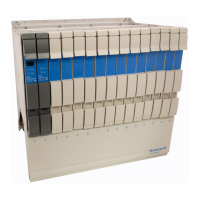8 Periodic Redundancy Tests
8.3 IOP Redundancy
460 HPM High-Performance Process Manager Service R688
Honeywell December 2020
HPMM swap verification
Perform the following steps to verify that redundant HPMMs will swap their primary and secondary
positions.
Select the <SYST STATS> (SYSTEM STATUS) key on the console and then select the
PROCESS NETWORK STATUS target on the display for the network that contains the
High-Performance Process Manager of interest. The UCN Status display is produced
on the console screen.
Choose the status box containing the High-Performance Process Manager of interest
and then select the DETAIL STATUS target on the UCN Status display. The HPM
Detail Status display is produced on the screen.
Select the RUN STATES target on the HPM Detail Status display. The SWAP
PRIMARY target along with other targets appear at the bottom of the display.
Select the SWAP PRIMARY target. This produces the ENTER and CANCEL targets to
the right of the SWAP PRIMARY target.
Note the status of the two HPMMs status boxes on the display and then choose one.
One status box should contain an “OK” label and the other status box should contain a
“BACKUP” label. Choose one of these status boxes. Then, select the ENTER target.
The “OK” and “BACKUP” labels in the HPMM status boxes should switch positions in
45 seconds or less, depending on the network size, and indicate the HPMM
redundancy is functional.
In addition, the Alphanumeric display on the High-Performance Comm/Control card will
also confirm to swap by switching the primary and secondary indications appropriately.
The orientation of the HPMMs can be returned to their original positions by selecting
the ENTER target a second time.
8.3 IOP Redundancy
Introduction
The ability of a redundant pair of IOPs to swap positions, primary to secondary and secondary to primary
is confirmed by using display commands on the Universal Station.
IOP redundancy terminology
IOP A: IOP A is the physical primary IOP. It is the IOP that is physically connected by cable to the
“A” cable connector on a redundant FTA.
IOP B: IOP B is the physical primary IOP. It is the IOP that is physically connected by cable to the
“B” cable connector on a redundant FTA.
Primary IOP IOP B is the physical primary IOP. It is the IOP that is physically connected by cable
to the “B” cable connector on a redundant FTA.
Secondary IOP: The secondary IOP is the logical secondary IOP. It can be either IOP A or IOP B
that is not controlling the FTA’s field terminals or providing the process variable.
IOP Swap: An IOP swap reverses the status of the physical IOPs, A and B. The present primary IOP
becomes the secondary IOP, and the present secondary IOP becomes the primary IOP.
IOP Bias: For the 8-channel Analog Output IOP only, operation with the IOP A as the primary IOP
and IOP B as the secondary IOP is with the basis, the preferred condition. Operation with the IOP B
as the primary IOP and IOP A as the secondary IOP is against the basis, the nonpreferred condition.
IOP redundancy test procedure
Perform the following steps for each redundant IOP configuration.

